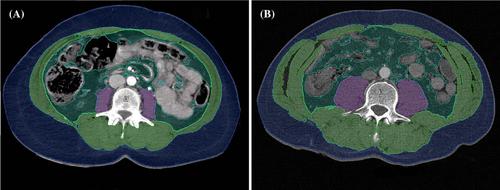High-energy trauma patients represent the ultimate challenge to trauma care and are at risk of injury-related mortality and morbidity—a common cause of loss of productivity. The aim of this study was to implement computed tomography (CT)-derived, artificial intelligence (AI)-based body composition analysis (BCA) to identify predictors of morbidity.
Retrospectively, we enrolled 104 patients (38 females and 66 males) who underwent CT imaging for assessment of injuries caused by high-energy trauma (motor vehicle accidents, falls from significant height, or blast injury). We sought to identify risk factors for prolonged length of stay in hospital and intensive care unit (ICU) and fractures requiring pelvic surgery. Cox and logistic regression analysis were performed using BCA parameters as covariates besides conventional risk factors. Additionally, the effects of pre-existing conditions, obesity, and sarcopenia were analysed.
Increased subcutaneous adipose tissue (SAT), determined by BCA, at hospital admittance is a predictor of prolonged hospital stay (P = 0.02) independent of treatment regime and occurrence of related complications, whereas muscle mass does not influence the length of stay. Individuals with sarcopenia and a decreased psoas muscle index (PMI) sustaining high-energy trauma are at risk of pelvic injuries requiring surgical treatment.
BCA parameters are easily available from routine CT and significantly predict outcomes in trauma patients with pelvic injuries. Patients with reduced muscle mass are at risk for injuries requiring pelvic surgery, and increased SAT is a risk factor for longer hospital stays. These findings underline the potential of BCA, which may be valuable in identifying trauma patients who require specific support to optimize their physiological reserves and clinical outcome.


